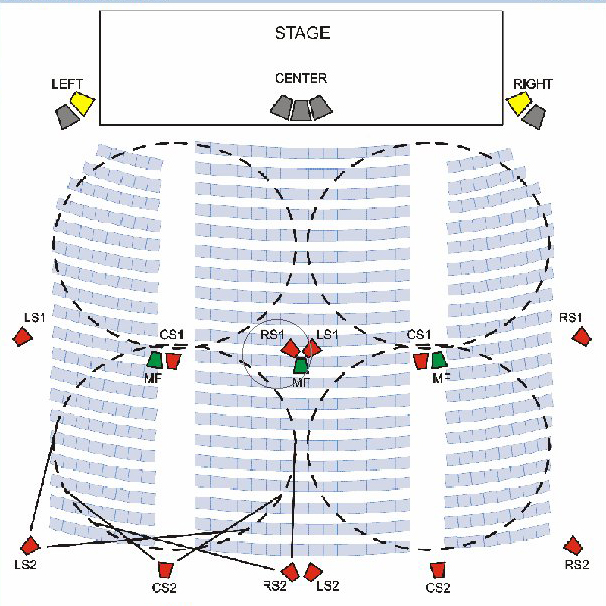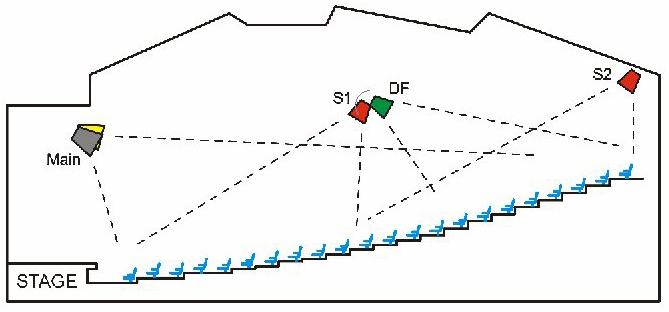
With correct level and delay settings, these will add loudness without degrading the clarity and localization of sound from the more distant main loudspeakers.
A mono mix of the front program material can be used to drive the delayed fills.
Zoning Considerations
The basic problem with surround in a large venue is that there is too much delay between the front and rear of the audience area.
To accommodate this, the audience area can be divided into sections that are small enough that a tolerable propagation delay spans them – perhaps 30 to 40 feet across. These areas are then individually covered with loudspeakers behind and above each area.
The loudspeakers will need good directivity control to minimize leakage to adjacent areas, and each will need its delay adjusted to properly synchronize it’s sound field with the front sound field arriving from the main loudspeakers.
A possible implementation is shown in Figure 4 and Figure 5.
All of the loudspeakers depicted need to be high enough above the audience to provide reasonably even coverage.
The delayed fill (DF) loudspeakers are fed with a mono mix of the front (left/center/right) channels, and delayed electronically so that their sound arrives to the listeners in the back just slightly later than the sound from the actual front loudspeakers. The levels are set low enough so that front localization is not disrupted.
The front-zone loudspeakers LS1, CS1, and RS1 may need little or no delay. They should synchronize with the front loudspeakers at the center of the zone they cover.
The rear-zone loudspeakers LS2, CS2, and RS2 will need delay to synchronize with the front loudspeakers at the center of the rear zones. In the example shown this would likely be in the range of 45 to 60 ms.
This concept uses a conventional left-center-right layout for front sound staging covering the entire venue, and provides individual surround performance to smaller groups of the audience so that front-to-rear timing is manageable.
For larger venues, more surround zones will be needed. The size of each zone cannot be increased without seriously degrading the front-to-rear time alignment. A good surround system can provide a sense of immersion in the sound field, and can simultaneously allow specific sounds to arrive from many various directions around the listener, as determined by the program mix.
The possibilities of spatial sound staging enjoyed by conventional left-right stereo can be expanded to all directions in a horizontal plane above the listeners. With a bit more equipment, overhead sounds could be added as well for a more complete audio experience.
Before using a live surround system, one needs to know the requirements of the performance, and how the sound should be spatially presented. This may depend on the desires of the composer, performer, producer, and/or the mix engineer. Then the appropriate loudspeaker utilization and drive scheme can be determined.


